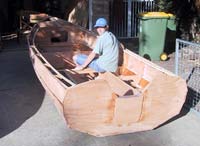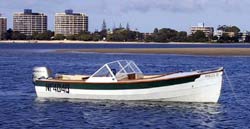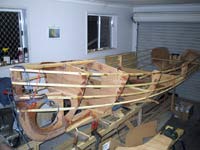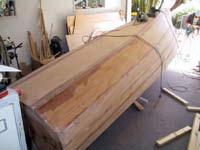|
Polly II
by Eric Ashby
Yesterday I put my wife aboard and we set off south in Polly II, our much loved Rifleman, now more than 2 years old. Our departure point was Caloundra, (the southern gateway to Australia's "Sunshine Coast") and the destination, a pie shop at the southern end of Pumicestone passage, a distance of 30 or so kilometres. The trip down was lovely. The Honda 25 singing us along at an easy 15 knots, the sun shining, and the view of the glass house mountains passing us by from various angles as we negotiated the winding and sometimes shallow waters of the passage. The Navman LCD kept us informed of the water depth and temperature, boat speed, engine vitals etc. I think this is a great piece of equipment. Just one compact device taking up little room on the dash, provides all the information needed in various formats as suits the drivers needs at the time. Funny I have a NZ designed boat with NZ instrumentation.
 (click images to enlarge)
(click images to enlarge) |
On arrival at our destination, a stern anchor was dropped with a bow line taken to a post outside the shops. The clear water was an inviting 27.5 degrees, but the pie shop won out. A few minutes later, immersed in the aforementioned water, we enjoyed pies that made the trip worthwhile. But thinking about that, even without the pies, a trip in a fine little boat, in waterways so scenic is worthwhile on it’s own merits. The pies were just a bonus after all. During lunch, a north east breeze sprung up, rippling the water and spoiling the mornings reflected views of the distant mountains, but making the trip home a little cooler.
Yesterday’s trip was just one more of many my family, friends, and I have enjoyed in Polly II. The log shows a distance of more than 600nm, which is not quite accurate. We had a warranty repair claim promptly attended with a replacement unit by Navman, however I did not record the distance on the replaced unit, which I estimate would have been 300 plus. As you see, Polly II has been around! During the trip yesterday, my wife commented, ‘this boat sure turns heads.’ She sure does! It is rare to get off the ramp and away without somebody stopping to ask all sorts of questions about her. My favourite was from a fisherman who asked, ‘Is she one of the original bow riders?’ I like the style of John Welsford's boats, and obviously, so do many others,.
A couple of comments may be of interest. When we first started using the boat, we were intrigued to find she heels to windward when running. I can’t remember if I asked John about this or not, but my son figured it out. As the bow rides just clear of the water when planing, crosswinds swing the bow downwind. The movement is not apparent with consistent breezes, and instinctively, the helmsman turns slightly upwind, inducing a natural heel in the turn. As this is not so much a turn as a maintaining of  course, the boat will continue straight and true but heeling. Moving crew weight slightly corrects trim and normal running. When first launched, I had fitted a pair of chairs, but found these restricted the ability to shift ones body weight. Subsequently we designed and fitted the ‘park bench’ seen in the picture. Now it is easy to sit wherever required to balance her. course, the boat will continue straight and true but heeling. Moving crew weight slightly corrects trim and normal running. When first launched, I had fitted a pair of chairs, but found these restricted the ability to shift ones body weight. Subsequently we designed and fitted the ‘park bench’ seen in the picture. Now it is easy to sit wherever required to balance her.
I guess this tenderness is a result of the narrow beam, but this beam is truly appreciated at the petrol pump. Our trip yesterday, perhaps 70 to 80 km, used about 15 litres of fuel! 2 or 3 days of ‘messing about in the boat’ usually costs $10 to $15. Very reasonable for the fun enjoyed.
Another handling note relates to turning. The hull runs like it is on rails. I guess it is on one rail in the form of the external keel. What we have found is that it is difficult to execute a tight turn when on the plane as the hull heels happily if a little alarmingly at times, but turns slowly. Well that was until recently. During construction, I apparently underestimated the screw lengths when fitting the keel. I used no epoxy here to allow replacement of this sacrificial component should the need arise. (Did I misunderstand your instructions in this area?) Anyhow the result was that whilst my son and a friend were driving the boat, recently, the outer keel came off. This happened a few kilometres from the ramp, so they turned around, recovered the keel, and returned to the car. What they discovered in the process was that the boat now handled differently. She cornered much easier.
 Following this, I dried out the screw holes and filled them with epoxy putty, planning to buy larger screws and refit the outer keel. Before doing this however, at my son’s suggestion, I tried the boat for myself. It does indeed corner much easier and less alarmingly as we do not need so much helm for the turn to begin, resulting in less heel angle for a tighter turn. Following this, I dried out the screw holes and filled them with epoxy putty, planning to buy larger screws and refit the outer keel. Before doing this however, at my son’s suggestion, I tried the boat for myself. It does indeed corner much easier and less alarmingly as we do not need so much helm for the turn to begin, resulting in less heel angle for a tighter turn.
Otherwise, we love our Polly II. We have learned her ways and how to load and adjust her to suit the conditions. The Honda 25hp 4 stoke is also a great little motor. Quiet economical and well mannered, it will still pull my 6 foot sons up on a wake board with 1 or 2 passengers in the boat. Mind you the boat is pulled around by them when they do some of their out wide manoeuvres, but then she is a dainty little boat, so she is forgiven. (She has planed with 6 adults aboard. Not a nice thing to ask of her though.) The only other thing on our wish list for her is the power tilt and trim option to enable fore and aft trim adjustments whilst under way.
Oh, and I would love to fit a canopy for protection from the sun, but refuse to bolt on one of the modern off the shelf units. That would be like putting a baseball cap on the Mona Lisa! The shop units just don’t have any style.
 Enough for now. Suffice to say that Polly II has a place in the hearts of our family the same as our beloved and departed cocker spaniel ‘Polly’ who spent just as much time in the water, and after whom our Rifleman obviously takes her name. John Welsford designed a lovely boat, as many a boat ramp observer has agreed!! Enough for now. Suffice to say that Polly II has a place in the hearts of our family the same as our beloved and departed cocker spaniel ‘Polly’ who spent just as much time in the water, and after whom our Rifleman obviously takes her name. John Welsford designed a lovely boat, as many a boat ramp observer has agreed!!
Now for my next boat, I love the look of the Navigator with the cuddy cabin. Once our boys have left home, I can see my wife and I anchored off the pie shop for the night, kettle simmering whilst we sit in the water enjoying our pies, following a more leisurely cruise down the passage. Then after dinner, we might just up pick and enjoy a night time cruise across the bay to Moreton Island. Ah the power of the dream.
 A couple of other comments. The Honda 25 seems to me to be an ideal motor. Perhaps the 30hp, which is the same size and weight, could be a little better, but I came by this motor almost new and in perfect condition for the right price. The only problem I have had with it was a refusal to idle and lumpy running a year or so back. This was caused by what look like fine saw dust particles in the fuel system and carbies. As the motor was in the under light covers in the garage during construction, I suspect particles must have settled in the air cleaner element. My fault. Would I go with the same motor if I did it again? Yes. No hesitation. (But add power trim.) A couple of other comments. The Honda 25 seems to me to be an ideal motor. Perhaps the 30hp, which is the same size and weight, could be a little better, but I came by this motor almost new and in perfect condition for the right price. The only problem I have had with it was a refusal to idle and lumpy running a year or so back. This was caused by what look like fine saw dust particles in the fuel system and carbies. As the motor was in the under light covers in the garage during construction, I suspect particles must have settled in the air cleaner element. My fault. Would I go with the same motor if I did it again? Yes. No hesitation. (But add power trim.)
As indicated above, the other thing we would like would be power trim and tilt. The Rifleman is a relatively lean hull, and sensitive to trim changes. This we found a little disturbing at first, but once we got to know her better and enjoy the smooth and economical performance, we learned to load her accordingly and enjoy the ride. Our most common loading occurs when my wife and I make up a foursome with another couple and go on a picnic cruise. The ladies like to sit in the forward cockpit leaning against the windscreen bulkheads, and with their legs outstretched. We chaps sit on the ‘park bench’ with the picnic supplies in the aft cockpit with the noise. Normally this provides for good weight distribution and a comfortable ride for all. On such a picnic cruise, I normally operate around 10 to 12 knots depending on the distance to be covered. (How long to lunch?) With 4 adults aboard in this manner, top speed is around 18 knots. With 2 adults aboard, 20 – 21 knots is tops. 1 teenager aboard claims to have seen 24 knots. (unconfirmed by dad.)
 Where we use her? We live in Caloundra on the Sunshine Coast, 1 hours drive north of Brisbane, Australia. I am a fair weather sailor on the whole and prefer to stay on the smooth inshore and inland waters. I have had her out over the bar here at Caloundra which she handled well, but I am ever mindful of the price of a mistake at the helm or staling the motor on an unseen sand bar etc.. Because of the planing shoe keel on the hull bottom, rather than the v bottom of production boats, she does tend to slam a little, but this has usually been corrected or reduced by adjustments to speed and trim. Never has she frightened us. We have explored most of the waterways around the coast and are now looking at the maps of Moreton bay and the Gold coast region. The NSW coastal river systems also of interest to us. Where we use her? We live in Caloundra on the Sunshine Coast, 1 hours drive north of Brisbane, Australia. I am a fair weather sailor on the whole and prefer to stay on the smooth inshore and inland waters. I have had her out over the bar here at Caloundra which she handled well, but I am ever mindful of the price of a mistake at the helm or staling the motor on an unseen sand bar etc.. Because of the planing shoe keel on the hull bottom, rather than the v bottom of production boats, she does tend to slam a little, but this has usually been corrected or reduced by adjustments to speed and trim. Never has she frightened us. We have explored most of the waterways around the coast and are now looking at the maps of Moreton bay and the Gold coast region. The NSW coastal river systems also of interest to us.
Construction wise, she is built from pacific maple marine ply with the stringers from hoop pine. Some meranti has been used as well. Obviously, Tas oak in the transom motor mount as per plan.
|

